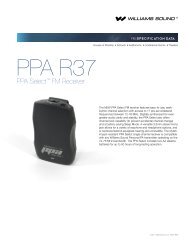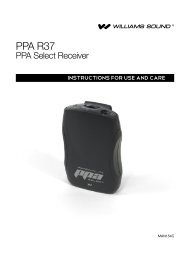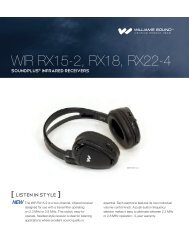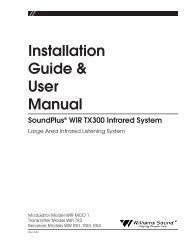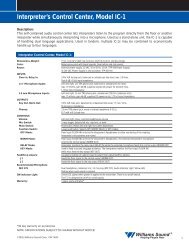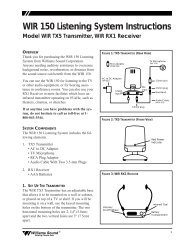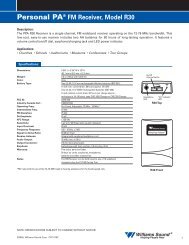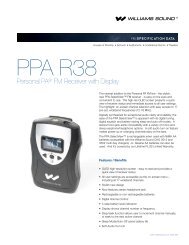Install Instructions - Williams Sound
Install Instructions - Williams Sound
Install Instructions - Williams Sound
You also want an ePaper? Increase the reach of your titles
YUMPU automatically turns print PDFs into web optimized ePapers that Google loves.
not helpful to the hearing impaired and can contribute to excessive noise in the receiveroutputs. See the section below, Deciding Between Compress Or Limit Settings.If an audio delay is available for use in large auditoriums, it’s usually best to use it.Because radio signals travel faster than sound, delaying the transmitted audio so that anaverage listener (in the middle of the listening area) hears the transmitted audio a fewmilliseconds after audio from the main sound reinforcement system speaker is helpful.This will also help audience members who lip read.The FM hearing assistance system transmits audio with very good fidelity, using thesame technical standards as commercial FM broadcast radio. Its quality is usually limitedby the audio source and by the earphones used with the receivers. Therefore, the audiosource signal should be of the highest quality possible.DECIDING BETWEEN COMPRESS OR LIMIT SETTINGSIt’s easy to select Compress or Limit using one position of the Audio Select Switch. Whenchoosing which mode to use, the system operator should consider the expected audience andprogram material. Figure 8 shows response curves for the compressor/limiter circuitry.A hearing impaired person’s perception of what is “too loud” is usually similar to a normalhearing person’s. However, they often don’t hear soft sounds as well. In other words, theirdynamic range is reduced. To compensate, the T4’s Audio Processor can compress the audiosignal, reducing the dynamic range and making it more useful to the hearing impaired.Some hearing impaired people cannot tolerate as loud a sound as those with normal hearing.When accompanied with hearing loss, their dynamic range is significantly reduced, both forsoft and for loud sounds. Compression is especially useful for these individuals.In some situations, however, such as concerts, compression is annoying to listeners—especially musical purists. Limiting provides control of the modulation level and isoptimized to cause a minimum of disturbance to the sound. It’s acceptable to the mostdiscerning listeners, but not as helpful to hearing impaired people as compression.FIGURE 8: T4 AUDIO PROCESSOR PERFORMANCE+100Hard Limiter (Always Functional)RELATIVE OUTPUT LEVEL–10–20CompressLimit–30Audio "-12 dB" Light ONAudio "0 dB" Light ON–40–40–30–20 –100RELATIVE INPUT LEVEL+10 +20<strong>Williams</strong> <strong>Sound</strong> ®Helping People Hear15



